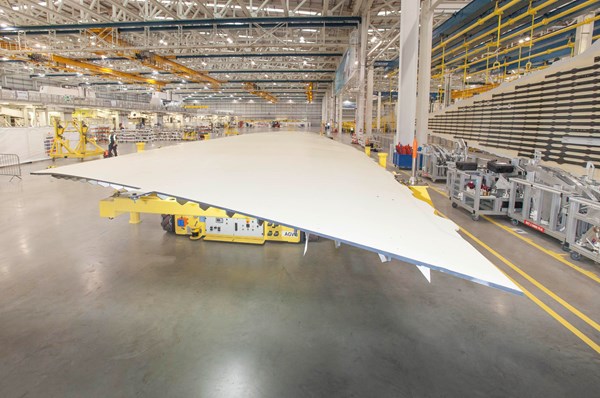Battle of the composite wings
A closer look at the wings of the Airbus A350-1000 and the Boeing 777X.

As CW reported earlier, the wings for the first Airbus A350-1000 have begun the process of assembly in Broughton, North Wales. This news is pretty significant to the composites industry as the company says the A350 XWB wing is the largest single part made from carbon fiber composite material in use in civil aviation today.
But let’s not forget about the Boeing 777X, which the Airbus A350 is in direct competition with. For the purpose of this blog article, let’s take a close look at the wings for each aircraft. So here’s what we know about the Airbus A350-1000. The A350-1000 wing has the same span of the A350-900 (105 feet) that is already in service, but 90% of the parts have been modified and the trailing edge has been extended to resize the wing for the additional payload and range. They are designed and developed at Airbus’ facility in Filton, near Bristol, where a number of other systems are designed and tested including fuel systems and landing gear.
Airbus touts that the high-performance wings of the A350 XWB make the aircraft faster, more efficient and quieter. The wing design includes several streamlined features. Among these are droop-nose leading edge devices and new adaptive dropped-hinge flaps, which increase the jetliner’s efficiency at low speeds.
To improve efficiency at higher speeds, the A350 XWB can deflect its wing flaps differentially, optimizing the wing profile and providing better load control.
The Boeing 777X wing will be big— the composite wingspan of the 777X measures 71.7m/235.4 ft, 6.95m/22.8 ft longer than the span of today's 777-300ER. The 777X features folding wingtips, which sound very interesting as Boeing says the that the 777X’s folding racked wingtip and optimized span will deliver greater efficiency, ‘significant’ fuel savings and complete airport gate compatibility (a biggie). Construction has started on the Boeing 777X at Boeing's Everett, WA, site with the manufacture of the carbon fiber composite wings to start in 2016.
These wing structures will include skins and spars fabricated via automated tape laying (ATL), which will be cured in one of the facility's three 37m autoclaves. Parts will be assembled into wings in the adjacent aircraft assembly plant.
Airbus is estimated to fly out of the gates first with initial delivery of the A350-1000 scheduled for 2017 whereas the first delivery of the Boeing 777X is targeted for 2020.
While both wings represent an advance for the composites sector, the real winner of the battle of wings will be determined based on how well the competing aircrafts perform – especially when it comes to sales and profits.
Related Content
-
Next-generation airship design enabled by modern composites
LTA Research’s proof-of-concept Pathfinder 1 modernizes a fully rigid airship design with a largely carbon fiber composite frame. R&D has already begun on higher volume, more automated manufacturing for the future.
-
Combining multifunctional thermoplastic composites, additive manufacturing for next-gen airframe structures
The DOMMINIO project combines AFP with 3D printed gyroid cores, embedded SHM sensors and smart materials for induction-driven disassembly of parts at end of life.
-
Plant tour: Spirit AeroSystems, Belfast, Northern Ireland, U.K.
Purpose-built facility employs resin transfer infusion (RTI) and assembly technology to manufacture today’s composite A220 wings, and prepares for future new programs and production ramp-ups.
















